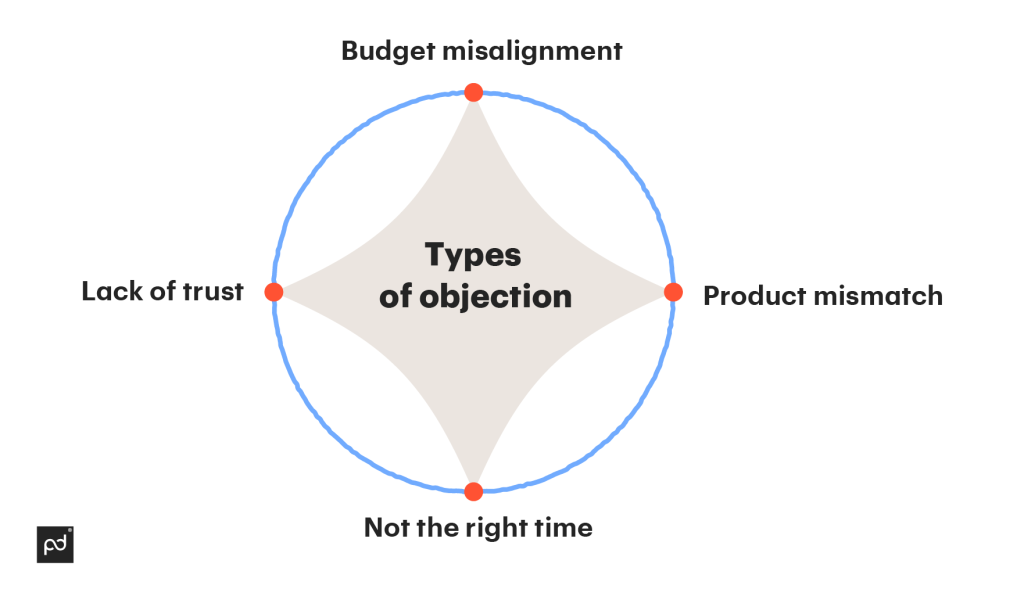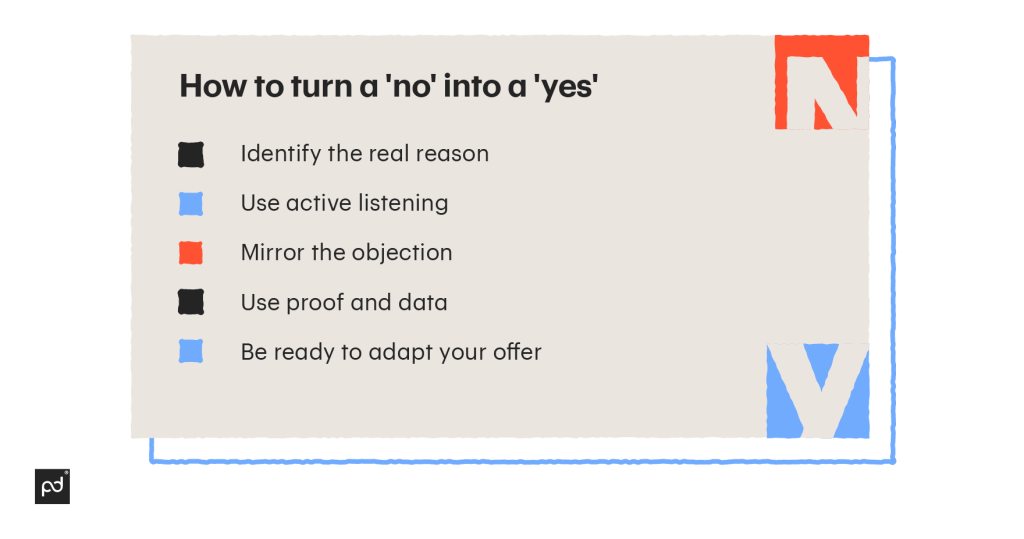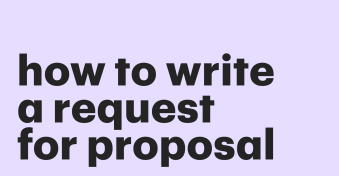Overcoming objections is a crucial part of the sales process — as is being able to gracefully end the conversation if the prospect’s “no” is definitive.
Often, objections stem from either a primary reaction of not wanting to commit (indecisiveness), not trusting the salesperson (lack of trust), or not being offered the right option (product mismatch) — rather than a hard “no.”
This means that there’s usually a lot of room for salespeople to negotiate and build trust or even a relationship.
This makes it all the more important to know how to handle objections the right way — and also identify the real reason behind them (which might be very different from what the other person initially states).
In this article, we’ll look at the different types of “no,” advise you on what you can do to turn each one into a “yes,” and also show you how to exit a conversation gracefully when there’s no chance of striking a deal and negotiating a contract.
First, we’ll give you some quick tips and ideas on how to respond when you hear a “no” — a collection of things you can say to not lose your standing and to actually bring the conversation forward.
Next, we’ll dive deep into the details of what a “no” means, the different kinds of “no” there are, and give you some actionable tactics to handle objections, ones you can immediately implement in the sales process.
How do you respond when a prospect says “no”?
The other person’s rejection during the sales process is often a knee-jerk reaction. It’s meant to give them more time to think, and not feel overwhelmed by the possibilities or by the need to commit, rather than a definitive “no” to what you’re offering.
In fact, according to the Harvard Business Review, many sales today are lost not to competitors but to prospective clients’ indecisiveness: anywhere between 40% and 60% of negotiations fail in the latter stages of the sales process after a prospect has expressed their interest but has decided against making a purchase at the end.
For this reason, it’s crucial to get beyond this initial “no” and see what stands behind it. Use this as an opportunity to build a rapport and not lose a lead to indecisiveness!
Understand the reason behind the “no” by asking the right follow-up questions. Such as:
- What are your priorities right now?
- Are you expecting any major changes in the next few months?
- What are the other options you’re considering at the moment?
- Are you currently using another product to solve this problem?
- What is your main concern with what we offer?
- If you don’t make a purchase, how will this affect your capacity to meet your goals in the next few months?
Don’t overwhelm your prospect with questions, though — choose 1 or 2 questions that are the most appropriate for the situation and listen carefully to their answers.
And whenever you ask a question during a call, take a deep breath and wait for the other person’s answer.
Don’t follow up with another question or clarification immediately, even if they take a moment to reflect — in fact, if they do, that’s a good sign! This means they’re really thinking about your question and don’t have a fast, ready-made answer.
As for email communication, leave the other person a few days to answer, but make sure you follow up with them at least once or twice.
Regardless of whether communication happens on the phone or via email, being supported by the right tools can considerably speed up and facilitate the process.
A CRM is a great addition to the sales process of any mid-sized and larger teams, alongside having contract management software like PandaDoc to facilitate the negotiation process.
The combination of the two enables you to build a relationship with your customers, and also create, store, negotiate, and sign contracts easier.
This way, you get to eliminate manual processes (which are both slower and more prone to errors), and consolidate the entire contract lifecycle in a single location.
And indeed, that’s what we’ve been observing: For example, by connecting Salesforce with PandaDoc, our customers have been able to decrease document creation time by 50% and increase conversion rates by 36%.
The different types of objections
Objections come in many shapes and sizes, and they can happen for a myriad of reasons. Your job is to first uncover the why behind the objection and not instantly jump on how to overcome it.
In fact, in most instances the why is the key to the how — which makes it extra important to listen carefully.

So is it…
- A lack of budget
- A lack of trust
- Not the right time
- Not the right product?
Let’s discuss the details of each type of objection.
Related to pricing: “We don’t have the budget for this”
A lack of budget could mean many things, but it’s sometimes related to the lack of perceived value or the perceived risk of investing in your solution.
This means that the best approach is not necessarily to offer a discount or a cheaper product — in fact, this might sometimes be the worst approach, as it might demonstrate a lack of confidence or further confirm the lack of perceived value.
In this case, a better approach would be to demonstrate the value of what you’re offering using data and similar case studies.
In some instances, however, the prospect’s budget genuinely cannot meet you on the price. If that’s the case, you need to figure out whether the price is, say, 5 or 10% higher than what they can afford, or if it’s more like a 40-50% mismatch.
If it’s the former — a relatively small percentage gap — it’s worth pursuing a deal and negotiating specific contract terms to allow for the sale to happen.
Draft the new conditions and send them to your prospect right after you finish the call — or even while you’re still on the phone with them.
Pro tip: that’s easier if you’re using the right proposal software like PandaDoc or other similar tools, since it enables you to be nimble and agile, and modify your quote almost immediately (and update everything instantly).
Related to timing: “Not right now”
Is it that your prospect isn’t ready to commit just yet due to specific constraints, or is it that they’re lacking a sense of urgency?
Pay close attention to the arguments they’re using and whether they’re saying vague terms like “next year” or are much more specific, as in “not before March.”
The first might mean that they’re simply trying to get off the call, while the second provides a much better possibility to negotiate — or to follow up.
Product mismatch: “This is not what I need”
Maybe your product doesn’t solve the prospect’s problem, or not entirely. If so, why?
Is it a feature that is lacking, or is it that they simply haven’t yet figured out how to use your product or service?
Would a hands-on onboarding process help them make the most of it and put their worries at ease? Do you have the right documentation (videos, user manuals, how-to guides, etc.) to help them get familiar with your offering?
Or would another one of your products be a better fit for your prospect? Cross-selling to existing customers is a tried-and-true tactic, but you can also sell related products to prospects.
In fact, being able to correctly identify your customers’ needs, care about them as people, and offer them the perfect solution is a key sales skill that paves the road for excellent customer satisfaction in the future.
And if your product simply cannot solve the prospect’s issue, be honest and straightforward about it — you might not get the sale now, but acting with integrity and openness better enables you to create and maintain successful long-term relationships.
Lack of trust: “Why should we choose you?”
Obviously, not every prospect will trust you, and that speaks to exactly what your job is — to win their trust by presenting data and solid arguments, but also simply by listening to what they have to say and working to build a relationship with them.
It’s also crucial that you know your competitors well and are able to compare your product or service to theirs.
When discussing the competition, be honest and objective and don’t try to discredit them — this leaves a bad impression because it makes you look insecure and doesn’t put your company in a good light.
Instead, present rational arguments about the things that truly make you better than others.
Top 5 sales tactics to overcome objections and turn a “no” into a “yes”
In this section, we’ll talk about the top five sales methods that best handle objections.
With dedication and sincere attention to detail, you can easily implement these into your sales process right away to get a better chance of transforming rejections into successful negotiations.
1. Identify the real reason
The real reason is sometimes completely different than what the prospect will first say.
For example, they might initially say it’s not the right time for them, when in fact they’re locked into an expensive subscription with a competitor that they don’t know how to end.
So, how do you uncover the real reason behind an objection? Here are some techniques you can use:
- Ask follow-up questions to see where there’s a mismatch: What does “not the right time” actually mean? Is it because they’ve already set their budget for next year, or is it because they’ve just signed another contract?
- Use mirroring to make sure you understand them correctly: Repeat back (in your own words) what they just said and ask for confirmation. More on that in a bit.
- Acknowledge their concerns: Acknowledge and validate what they’re voicing, and where it’s coming from. This doesn’t mean that you’re confirming or agreeing — it simply means that you understand why they’re worried. This way, you’re building a relationship of trust in which the prospect could open up to you and tell you more about the reason why they’re rejecting your offer.
2. Use active listening
When you ask questions, give the other person enough time to answer.
Sometimes, just by waiting a few extra seconds, you’ll prompt them to add something else, which could be an invaluable piece of information and give you an important opening into what they’re actually thinking.
Never rush the conversation. Take the time to actively listen to the other person and use mirroring to make sure you’re on the same page.
This way, they’ll know that you actually care about what they have to say and aren’t simply following a hollow sales script you’ve memorized and used with all prospects.

3. Mirror the objection
Repeat the objection to make sure you’ve understood it correctly. This makes the other person feel validated and understood and helps you build rapport and trust.
For example, you could say,“From what I’m hearing, our solution is more expensive than what you were expecting to pay. Did I understand you correctly?”
If you did, they’ll feel understood, and if you didn’t, they’ll have an easy way to correct you. In both cases, you’re making valuable progress.
4. Use proof and data
Proof sells — especially if you know your data. If the reason for the objection is a lack of trust, showing your prospect several success stories can help build the trust that’s missing.
Use case studies that are similar to your prospect’s situation to show how you can provide value, even in ways they didn’t expect or consider.
Presentations can also be a good sales technique when you feature the right data — but make sure you don’t overwhelm the other side with too many details.
5. Be ready to adapt your offer
If your lead is saying “no,” what, exactly, are they saying no to?
Once the real reason is uncovered, you could modify what you’re proposing. Here are a few examples of how you could adapt your offer in the case of a:
- Product mismatch: If the person is saying “no” to the specific product you’re offering, it means that it’s not solving their pain point. Would a different product better fit their needs? Maybe they’re not looking for a full redesign of their website but want to simply improve their home page and optimize it for conversions.
- Budget misalignment: If your solution is too expensive for your prospective client, would you be able to offer a cheaper alternative? Or maybe propose a discount? Or offer a yearly plan that’s less expensive?
- Lack of urgency: Sometimes, people will simply say “no” and postpone making a decision because there’s no real urgency. Are you able to make a time-sensitive offer to avoid this?
What should you do if the “no” is definitive?
Sometimes a “no” is, at the end of the day, a “no,” and there’s nothing you can do about it.
If there’s really no chance of closing a deal with this prospect and you’ve figured that there’s no way for you to overcome their objections, the best thing to do is to end the conversation and move on. Otherwise, you’re wasting both your time and theirs.
If you continue chasing a deal after a no, this takes time away from other potential deals you could be negotiating.
Attempting to turn every “no” into a “yes” will drain precious resources you can invest in talking to other prospects who really need your solution — and can’t wait to say “yes.”
So, don’t chase after uninterested leads or tire kickers (find out what are tire kickers); instead, learn to identify them and then move on.
So, how should you close the conversation if a “no” is, in fact, a “no”?
There are a few things to do as you end the call:
- Ask for feedback (if you haven’t by now)
- Ask whether you can stay in touch or follow up later (and schedule a follow-up call if appropriate)
- Thank the person for their time and end the conversation
A “no” is also a learning opportunity that gives you valuable information about your market and about your sales process.
After a rejection, there are a number of things you can do to leverage this opportunity:
1. Add notes in your CRM about the reason
This will enable you to analyze trends later on.
For example, are many prospective customers saying no because of the looming economic crisis? You might need to adapt your messaging.
2. Discuss objections with your team
What objections is your team getting as a whole?
Are there any common patterns? Have some of the sales representatives figured out a smart way to overcome a specific objection?
3. Look for ways to better qualify leads
Is there something specific you can do to improve your lead qualification process?
If so, this will help you spend less time with the wrong leads in the future and identify the most promising opportunities faster.
4. Look for ways to improve your sales process
There are always things you can do to optimize sales. Maybe creating a sales playbook will help make sure everyone is on the same page?
Or maybe implementing sales battle cards into your process will help you move prospects faster through your sales funnel?
5. Look for ways to improve your own sales strategy
Your own sales strategy could maybe use some polishing.
Are you presenting the technical details of your solution too early, and overwhelming prospects with too much content?
Are you not asking the right questions? After each call, you can take a couple of minutes to identify specific things you could improve next time.
Make the most of every objection with the right strategy
Some objections are a clear, definite “no,” while others leave room for negotiation.
Whatever the type of objection you receive, there’s always more you can do: Either ask more questions to uncover the real reasons behind it, negotiate together contract terms that work well for both sides, or use it as a learning opportunity to hone your sales skills and improve your process.
Based on the specific type of objection you’re hearing, you need to adapt to it and decide on the best tactics to use.
This will help you achieve the best results for yourself, your team, and your organization.
Originally published February 25, 2017, updated October 21, 2022
Disclaimer
PandaDoc is not a law firm, or a substitute for an attorney or law firm. This page is not intended to and does not provide legal advice. Should you have legal questions on the validity of e-signatures or digital signatures and the enforceability thereof, please consult with an attorney or law firm. Use of PandaDocs services are governed by our Terms of Use and Privacy Policy.


